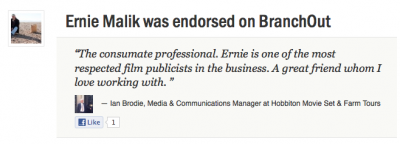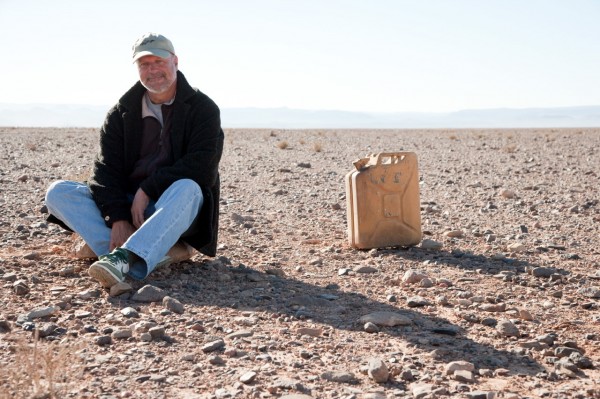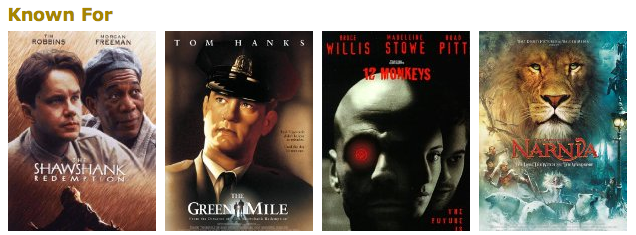 Ernie Malik (via IMDB) is a highly regarded film publicist. He has worked on major motion picture projects including the Shawshank Redemption, The Green Mile, Terry Gilliam’s Twelve Monkeys and more recently the Chronicles of Narnia: Voyage of the Dawn Treader and The Green Lantern. I had the pleasure of being introduced to Ernie while he was in Queensland as publicist on Chronicles of Narnia: Voyage of the Dawn Treader where Ernie generously agreed to meet with me and imparted to me some great advice about how to pursue a career as a unit stills photographer.
Ernie Malik (via IMDB) is a highly regarded film publicist. He has worked on major motion picture projects including the Shawshank Redemption, The Green Mile, Terry Gilliam’s Twelve Monkeys and more recently the Chronicles of Narnia: Voyage of the Dawn Treader and The Green Lantern. I had the pleasure of being introduced to Ernie while he was in Queensland as publicist on Chronicles of Narnia: Voyage of the Dawn Treader where Ernie generously agreed to meet with me and imparted to me some great advice about how to pursue a career as a unit stills photographer.
In fact, my decision to start writing my Tech Talk articles was inspired from some of Ernie’s advice to me.
What are some of the publicity campaigns or achievements you are most proud of?
For various reasons, I’m proud of several on-set campaigns in which I’ve been involved. Without going into great detail, here are a few titles and the reasons for which I am proud of any achievements.
THERE’S SOMETHING ABOUT MARY (1998, Miami) – IMDB Link:
The studio won that year’s Motion Picture Showmanship Award from the Publicists Guild, the highest honor bestowed for a p.r. campaign (both during production and the film’s release); being the on-set coordinator, I shared in that award (the film was the first of five I’ve done with the Farrelly Bros.)
THE GREEN MILE (1998, Hollywood) – IMDB Link:
Stephen King visited the set for just 3-4 hours one day (on his birthday, Sept. 21, 1998) and was very gracious in allowing me access to him for media (we did an L.A. TIMES interview on-set; a photo opp with director Frank Darabont and Tom Hanks which wound up in USA TODAY the following week; an EPK Q&A about the writing of the book and its adaptation by Darabont into a movie; and a photo opp with his celebratory birthday cake, quite a lot to do in 3-4 hours)
THE ALAMO (2003, Austin) – IMDB Link:
because the project was filmed in Texas (Austin, not San Antonio), I felt it necessary to allow every major state newspaper to visit the set and file a production story while filming continued; we achieved all that (with papers from Dallas, Austin, San Antonio and Ft. Worth) and got great local coverage for the movie.
FRIDAY NIGHT LIGHTS (2004, Texas) – IMDB Link:
we filmed for three weeks on location in Odessa, TX, where the story takes place; there was hesitation by the studio to actually shoot in a town that despised Buzz Bissinger’s book; upon our arrival there, the local newspaper writer assigned to the film asked if he could visit the set every day during the three week, a very unusual request; we allowed it and got 19 cover stories in the ODESSA AMERICAN from this reporter, Cliff Hamilton; also, we began filming on a Thursday, and I suggested to the producers that the production throw a tailgate party that first Friday after filming wrapped around 6:30 pm, inviting the Mayor and 200 of his personal friends; Billy Bob Thornton stayed for the party (the set caterer grilled hot dogs and hamburgers) and the front page newspaper story the next day had a photo of Thornton shaking the Odessa Mayor’s hand; also in Odessa, I hosted four media outlets one Friday night during filming of one of the story’s crucial football games — NY TIMES, ESPN, SPORTS ILLUSTRATED and EPK, and somehow managed to get all that work done in eight hours!
CHRONICLES OF NARNIA: THE LION, THE WITCH AND THE WARDROBE (2004, New Zealand) – IMDB Link:
our set was closed to local media for security reasons, so I had to get creative in handling the constant onslaught of media requests; without ever bringing a reporter to the working stages, I staged a few “set visits” involving some of the animals we imported from the States, none of which were indigenous to NZ — reindeer and wolves.
As filming wound down, we brought a cadre of press out to the local farm where the wolf pack (10 animals) resided during production; the reaction from the press who had never seen a wolf with their own eyes was eye-opening, startling and very poignant; with the reindeer, the government ultimately chose to disallow four reindeer from entering the country (due to a unique virus they carry that is nonexistent in NZ), so a Hollywood SFX company manufactured four animatronic reindeer for the scenes showing the White Witch in her sleigh; we invited the local newspaper and TV networks out to the studio facility to show them the reindeer, all the time telling them we had reindeer in the film; you can imagine the stories they filed when they arrived fully expecting to see real reindeer, then realizing they were “reel” reindeer
WE ARE MARSHALL (2006, West Virginia) – IMDB Link:
a moving, true story about the 1970 place crash that claimed the lives of most of Marshall University’s football team, we filmed on the actual campus and in the town where this tragedy took place, kicking off production with a press conference and a block party in Huntington, WV, where over 10,000 locals showed up to be greeted by star Matthew McConaughey.
We also filmed the movie’s final scene at the campus’ solemn fountain which honors the fallen, with most of the 500 extras that day locals with a history connected to the school and tragedy; we allowed the local media to cover the day’s shoot, making many friends in town during our four-week stay there.
There can a be a bit of confusion as to what the unit publicist does for a film – how would you describe what your role entails? How does it fit in with the film’s overall marketing strategy?
A unit publicist is the studio’s marketing rep on a working film set during production, handling media set visits, ad photo shoots, production of the DVD materials and other such duties.
Because a film production equates to a small (or large) short-term corporation, you are also the spokesperson for that corporation.
You also act as an ambassador to most set visitors, be it press, dignitaries or studio executives.
Essentially, at the studio’s direction, you assist in launching the project’s marketing campaign in the media while filming progresses, regardless of how long in advance production happens before the film’s release date.
You prepare written materials (synopsis, cast/crew biographies, production notes) for media distribution, whether the set welcomes media visitors or not (there are as many “closed” sets as there are those that schedule media visits).
You host the media on-set (TV, print, radio, internet) and arrange interviews for them with the key cast and filmmakers.
Sometimes, those visits result in immediate placement in the media; other times, the stories are embargoed by the studio to coincide with the film’s release…ideally, after a major media outlet visits and gathers all their materials, a teaser story runs say at the end of filming, with the larger article at time-of-release.
If a set is closed to media, you can enact ways to obtain publicity such as photo plants, column items in the entertainment media, etc.
You are a cog in the wheel of the studio’s marketing campaign, concentrating on the public relations aspect of that campaign. The role is a vital one in the studio’s marketing efforts, with the publicist planting the early seeds of the p.r. campaign which will grow into the larger marketing effort closer to the film’s release.
At what point in a show’s schedule do you usually commence and end?
It depends on the scope of the project. For large tentpole films, you could have a month’s prep and similar wrap. For smaller projects, the norm is a week’s prep and 1-2 weeks wrap.
During prep, you prepare the start-of-production release, update the industry trade paper film charts, begin collecting biographic background on the cast/crew and review the shooting schedule for opportunities for media and EPK coverage.
During wrap, a typical report recapping publicity achievements is prepared, along with finishing unit photog IDs and writing the presskit notes for the studio.
What are your primary publicity goals when working on a show?
Awareness for the project is always the primary goal of a public relations/publicity campaign. If the studio represents the symphony orchestrating the campaign, the on-set publicist is one of its key instruments.
The goals for a production publicist vary with the project at hand. There are films where media visits become a revolving door, what I like to call “publicity by the pound,” where every usual major media outlet gets invited to cover the production, including small TV markets in a “junket” style visit.
There are those where a specific campaign begins while filming ensues, whereby the studio carefully chooses outlets deemed suitable to their overall campaign (one major newspaper like the N.Y. Times, one major magazine like Vanity Fair, etc.).
There are also films where media will not be invited, a “closed set” policy implemented by the studio or filmmakers because of the sensitive subject matter of the film (like “Brokeback Mountain”) or cast members and filmmakers who prefer to have no media while they’re working.
There are still ways to begin building awareness even if a set is closed (photo and column item plants either in the consumer press or online).
I guess the main goal is to complete all media set visits successfully, i.e. the journalist(s) observe filming, talk with the key players (cast, filmmakers), tour the sets and walk away with a once-in-a-lifetime experience.
The unit publicist is one of the tools to help build awareness early on, with the studio taking those achievements on set and expanding on them as they approach the film’s release date.
Can you foresee the publicity still image being redundant to the process of publicising films?
No, even though video is as important and maybe more so.
Do you expect the images culled to only a few of the best images or do you prefer greater choice of being delivered sometimes hundreds of images?
I still say have the unit photog shoot as much as they feel he/she needs to capture the documentation of the project…even though the work is edited down to a few hundred key images.
You can choose to edit the amount of any specific scene, but each scene much be documented.
Are there any steps you’d encourage an aspiring photographer to undertake to improve their career prospects?
Stay current on equipment and digital aspects of photography.
From your perspective, what are key traits in a unit stills photographer?
1. maintain a quiet presence on the set while establishing your identity on the set
2. capture not only the scene, but behind-the-scenes as well, still an important aspect of documenting a film production
3. do not overshoot
4. if specific requests are made by filmmakers or cast, ensure you get them
5. work closely with the publicist…while both are individual entities on a set, I usually define this partnership as “flack and click”
If you had the opportunity to select a director and key cast for a film you were to work on who would you pick and what genre would you choose?
Director — Clint Eastwood (a consummate storyteller)
Actor — Richard Gere (a consummate pro who has rarely given a bad performance)
Genre — Musical

Ernie Mailk - photo courtesy of François Duhamel


your blog is just so rich in information, i’ve spent the last week addicted to it! Thank you for sharing :)